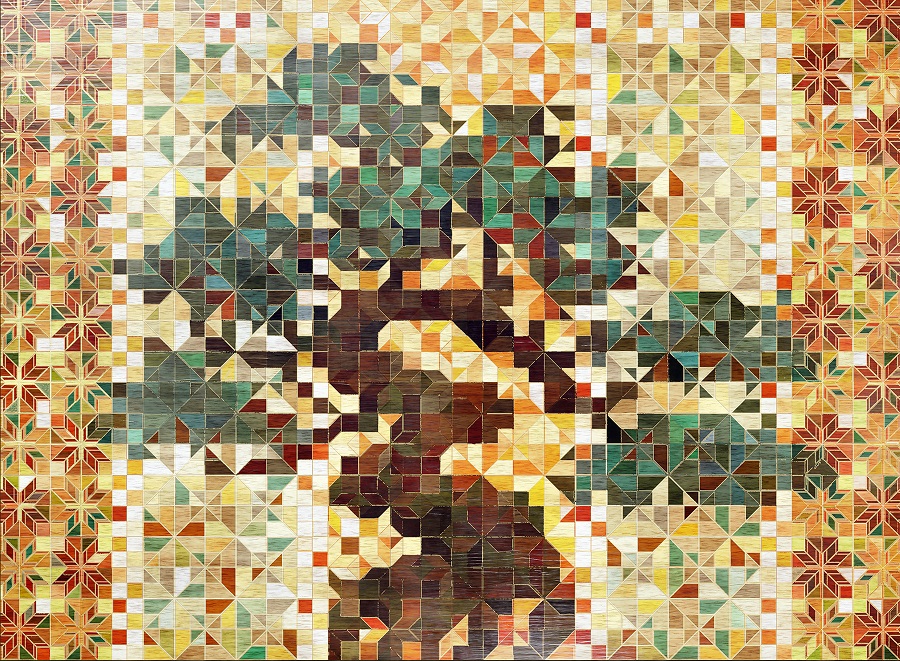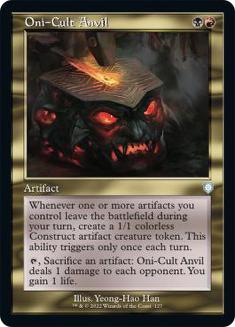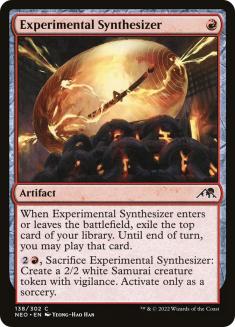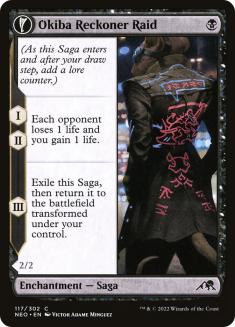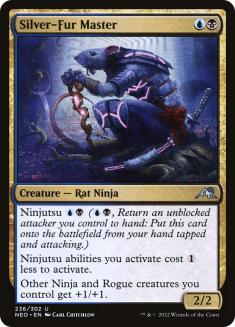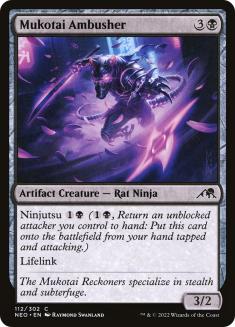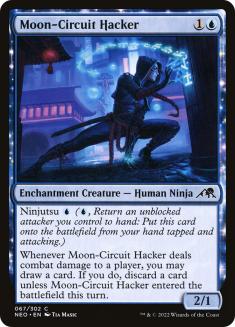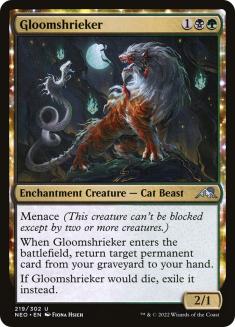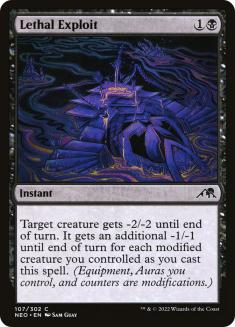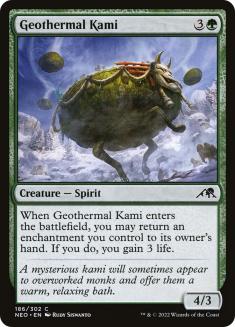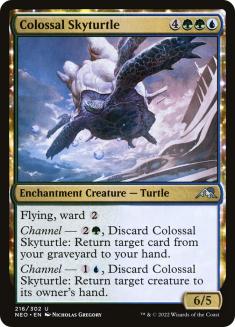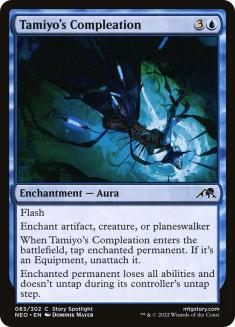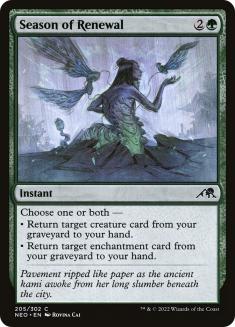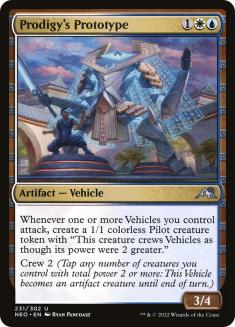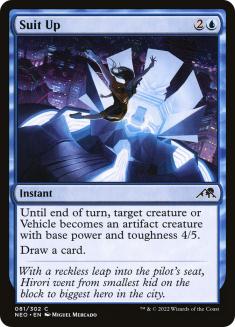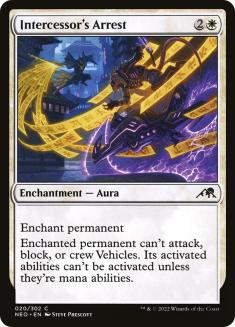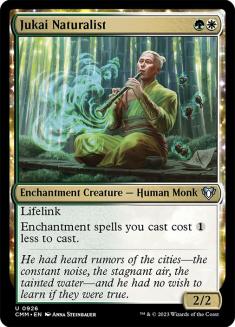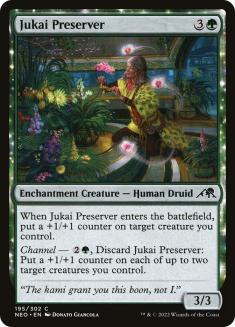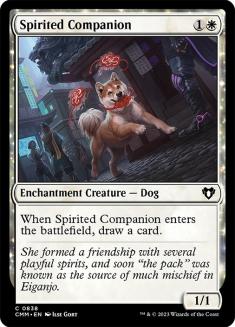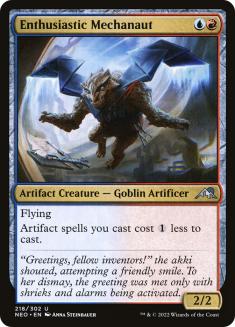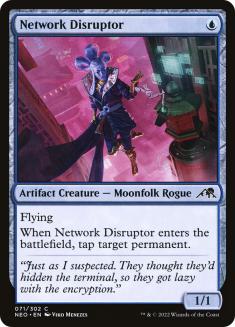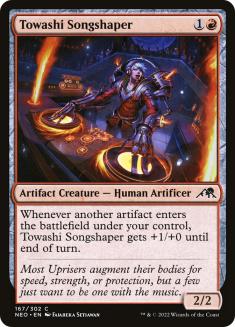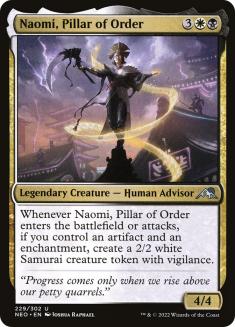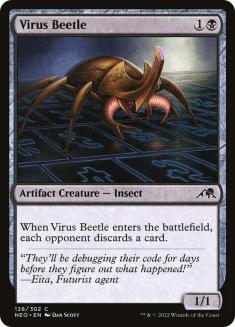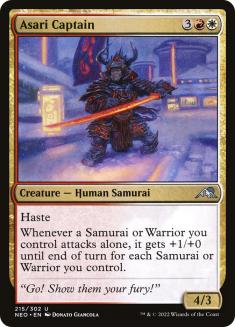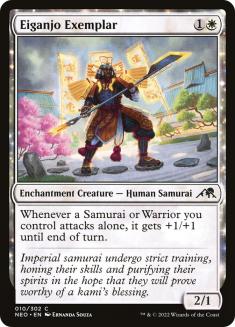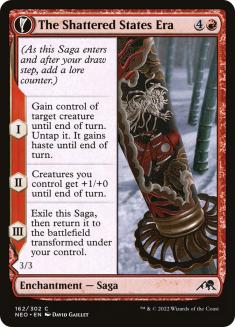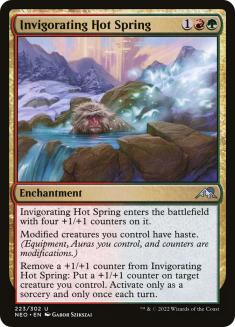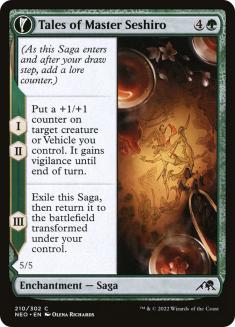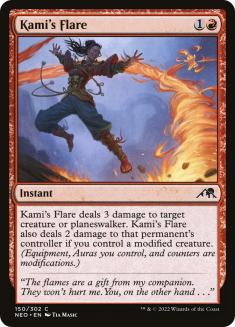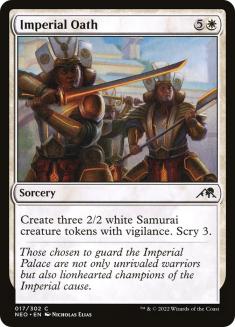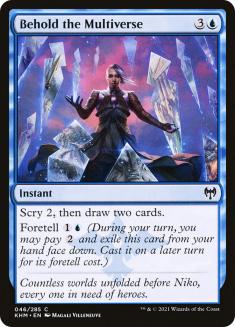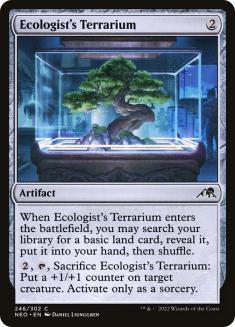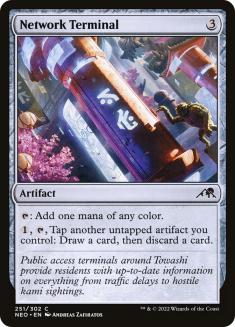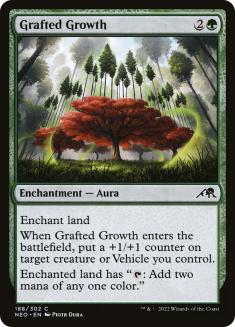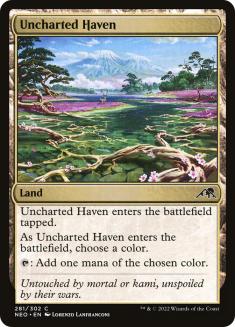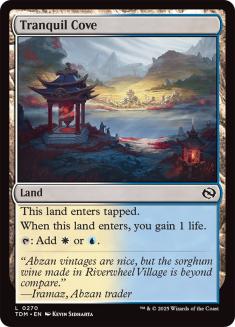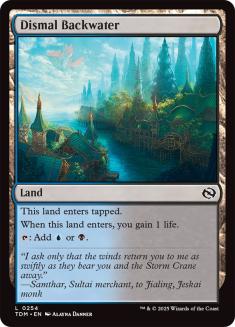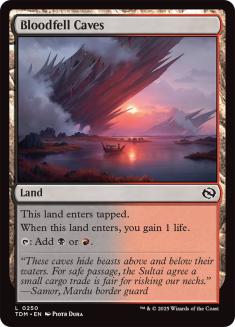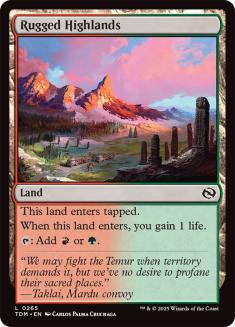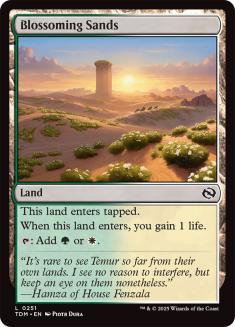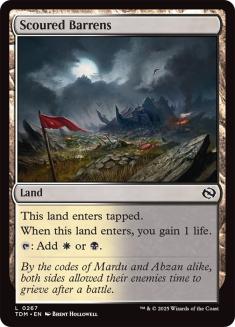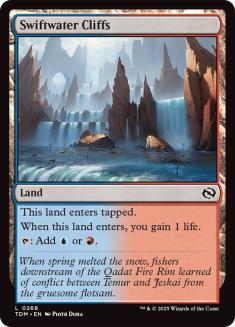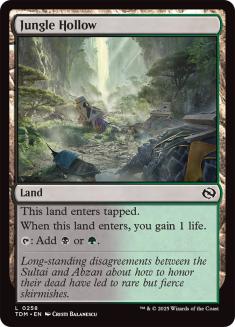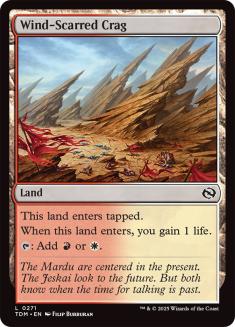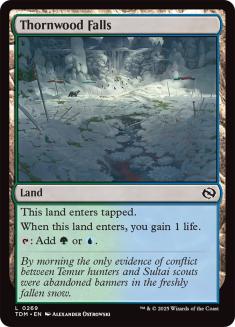Kamigawa: Neon Dynasty Premier Draft returns to MTG Arena this week before riding off into the neon sunset on July 24th. The set was generally well received, aside from a few problematic cards we can tackle later. Both “new” mechanics, channel and reconfigure, provide plenty of meaningful gameplay decisions, with the returning ninjutsu mechanic putting focus on combat.
I have to say, it’s a pretty special thing when roughly eight color pairs are pretty close on average power level, with no single, two-color archetype being a clear “best deck” of the format. Let’s take a look!
Tier 1
Rakdos
Rakdos is one of the fastest archetypes, featuring an artifact sub-theme. When the speed of the deck doesn’t quite land the lethal blow to your opponent, the deck can also use Clawing Torment, Ironhoof Boar, or Simian Sling for direct damage. Iron Apprentice is very strong in this deck, and can lead to some very powerful plays with cards like Voltage Surge. Both Towashi Songshaper and Experimental Synthesizer can be very powerful with Oni-Cult Anvil. Papercraft Decoy and Patchwork Automaton are unassuming creatures that can be great in the right decks.
Dimir
Dimir is all about using the ninjutsu mechanic. A common mistake is to put too many Ninjas in the deck. It’s important to include cards that will enable you to sneak attackers through, like Network Disruptor, Clawing Torment, or Inkrise Infiltrator. This deck will often encourage your opponents to play defensively, blocking when possible, making Suit Up even more powerful here. There are lots of creatures that benefit from being a Trojan Horse for your Ninjas, like Searchlight Companion, Circuit Mender, or Virus Beetle.
Pro Tip: There is a window after combat damage is dealt when your creatures are still recognized as “unblocked attackers”. This means you can ninjutsu another Ninja onto the battlefield after connecting with Moon-Circuit Hacker. Full control is required to sequence this properly on Arena.
Tier 2
Golgari
Golgari is a value-oriented deck headlined by Gloomshrieker. There’s no right or wrong way to build the deck, as it can take on various forms depending on the synergies you find during the draft. It’s important to make sure that your early-game is covered, as that is where you can lose most games with this deck. Fang of Shigeki, Bamboo Archer, and Lethal Exploit can fill this role well. The deck will look to grind out your opponents, often winning via medium creatures or a single large creature like the transformed sides of The Long Reach of Night and Boseiju Reaches Skyward.
Simic
Simic is very similar to Golgari, and it’s very common to see variations of Sultai with a green base to have access to powerful uncommons. Because Simic is a slow deck, it’s critical to have a play by Turn 2. Once again, Fang of Shigeki and Bamboo Archer are necessities to help you stave off early pressure, with Go-Shintai of Lost Wisdom joining them. The combination of Colossal Skyturtle and Season of Renewal creates a loop, netting you a card each cycle. As Simic is a very mana-intensive deck, I am often happy to play Grafted Growth, which can help you cast splashed cards like Imperial Oath.
Azorius
Azorius has the Vehicles theme; however, there are is a big gap between good and bad Vehicles. The only (nonrare) Vehicles you should put in any deck are Brute Suit, High-Speed Hoverbike, Imperial Recovery Unite, and Prodigy’s Prototype. Prodigy’s Prototype doesn’t require any additional Vehicle support, as it can get out of hand on its own – and take over games in multiples. I find Born to Drive a bit underrated. Putting the Aura on pretty much any creature will win you the game if they don’t have an answer, with the channel ability enabling some awesome plays as well. Moonfolk Puzzlemaker is one of the better creatures to crew Vehicles, and Skyswimmer Koi works well in the deck to help filter your draws later in the game.
Selesnya
Selesnya cares about enchantments, and can have some of the strongest starts via Generous Visitor. Era of Enlightenment is very good in this deck, as you don’t have a ton of control of your draws. Golden-Tail Disciple is surprisingly good as well with access to +1/+1 counters via Jukai Preserver or Tales of Seshiro. Michiko’s Reign of Truth can be game-breaking in these decks as well, forcing chump blocks or enabling giant lifelink attacks. Tamiyo’s Safekeeping is a great trick in this deck, allowing you to empty your hand quickly while protecting your best creature.
Izzet
Izzet is another artifact deck, but it functions differently from Rakdos. It plays out like a classic tempo deck, using cheap creatures to apply pressure while answering blockers with cards like Voltage Surge, Kami’s Flare, or Moonsnare Specialist. This is another great deck for Suit Up, allowing you to attack every turn. There are some more value-oriented builds that use cards like Restoration Specialist and Mirrorshell Crab, though these are far less powerful than the aggressive builds.
Tier 3
Orzhov
Orzhov is a midrange build that benefits when controlling both an artifact and an enchantment. Banishing Slash, Assassin’s Ink, and Kami of Terrible Secrets are among the best payoffs, and while I’m a big fan of Roadside Reliquary in general, it’s obviously a bit better here. The deck has access to great removal and card advantage, so it’s important to keep in mind how you will actually kill your opponent – I’d recommend Imperial Oath.
Tier 4
Boros
Boros tries to make use of the Samurai and Warrior creature types, with payoffs if you send only one fighter into the fray. This doesn’t play out too well in practice, and the majority of the payoffs aren’t really worth the hassle, aside from Asari Captain and Selfless Samurai. Occasionally you can pop off with Heiko Yamazaki, the General, or Norika Yamazaki, the Poet, but they can be underwhelming if things don’t line up well. There are some unassuming Warriors and Samurai, like Unstoppable Ogre, that can meet the criteria.
Gruul
As an avid Fires of Yavimaya supporter, my first two drafts of the set were Gruul. The power level of the cards in those decks was top-tier, yet the decks performed very poorly. The problem with Gruul is that it doesn’t do what Gruul traditionally does, smash. Gruul looks to use the modify keyword, which is “counter”-intuitive, pun intended. Taking time to modify what should already be one of the biggest creatures on the battlefield doesn’t make much sense, especially considering that the “payoffs” are minor at best. The other problem is that the deck can’t really race the faster decks, and is too easily stifled by slower value decks. I think this is the worst two-color archetype of the format.
Noteworthy Cards
Imperial Oath is arguably the best common in the set. This card is so powerful in part because of how easy it is to splash into nonwhite decks. Only needing a single white mana by Turn 6 is pretty easy to accomplish. Your Imperial Oaths get exponentially better in multiples, as you can cast them turn after turn.
While there are other uncommons somewhat similar in average power level, like Kappa Tech-Wrecker, Life of Toshiro Umezawa, and Blossom Prancer, Behold the Multiverse has the potential to win entire games by itself. Sometimes it doesn’t line up all that well, resulting in a very good card – but when things line up nicely, this card feels like a mythic rare.
There are a couple of artifacts that will help fix mana, but neither is too impressive by itself. I would recommend avoiding them in most decks. Grafted Growth can be great for four- and five-color decks, as well as mana-hungry decks.
Uncharted Haven is a very good land worth picking up early in your draft. This will give you a lot of flexibility for the rest of the draft, allowing you to pick up any Imperial Oaths or off-color rares that come your way.
Kamigawa: Neon Dynasty has some great mechanics, and a nice representation of most archetypes on the ladder. I’d recommend getting in some drafts before the neon lights turn off.
Lose and Learn, Learn and Win!

